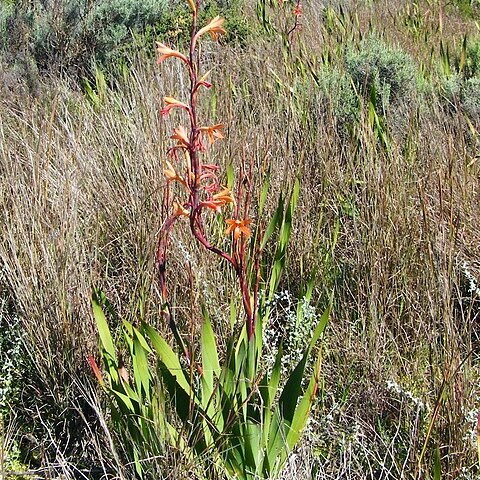Plants 1000-1200 mm high. Corm depressed-globose, 40-60 mm diam.; tunics coarsely netted. Stem branched, with 1 to several short, suberect branches. Leaves 5 to several, lower ± basal, upper leaves partly sheathing stem, ± half as long as spike, narrowly lanceolate to lanceolate, 12-20 mm wide, midrib and margins lightly thickened and narrowly to obscurely hyaline; bract-like cauline leaves 1 or more, long and tightly sheathing. Spike lax, up to 18-flowered; bracts herbaceous and often dull reddish purple, dry and brownish apically, 9-14(-16) mm long, inner as long as or slightly longer, acute or bilobed apically for up to 1 mm. Flowers zygomorphic, scarlet (rare yellow mutants recorded), often with pale longitudinal streaks running down tube from tepal sinuses; perianth tube with lower part (15-)18-22 mm long, emerging 10-14 mm from bracts, upper part horizontal, subcylindric, 20-22 mm long, 5-7 mm diam. at mouth; tepals narrowly oblanceolate, 19-25 x 4-8(-10) mm, upper ascending to horizontal, lower recurved. Filaments unilateral and arcuate, 30-38 mm long, well exserted from tube; anthers 7-10 mm long, purple-black. Style dividing near apex of anthers, branches ± 4 mm long. Capsules fusiform, 25-35 x 8 mm. Seeds nearly linear, 9-15 x 1.5-2.0 mm, 2-winged with distal wing largest.
More
Perennial herb, geophyte, 0.8-1.2 m high; corm depressed-globose, tunics grey-brown, coarsely reticulate; stem with ± erect branches. Leaves ensiform, 12-20 mm wide, margins and midribs thickened and hyaline. Bracts herbaceous or flushed dull red-purple, apex brownish. Inflorescence a lax spike; flowers scarlet; perianth tube 36-44 mm long, tubular above; tepals 19-25 mm long, narrowly lanceolate. Stamens unilateral, arcuate; filaments 30-38 mm long; anthers 7-10 mm long, contiguous, purple-black. Ovary oblong; style arching over filaments. Flowering time Nov.-Jan. Capsule fusiform.
Cormous geophyte to 1.2 m. Leaves sword-shaped. Flowers scarlet, tube elongate. Capsules attenuate.

